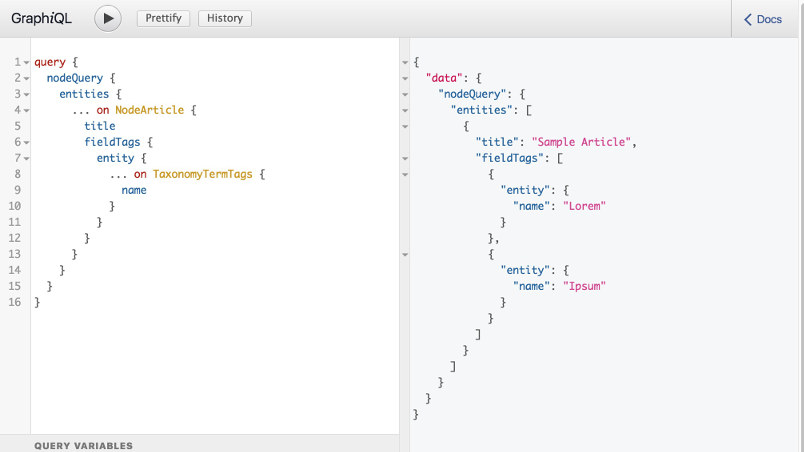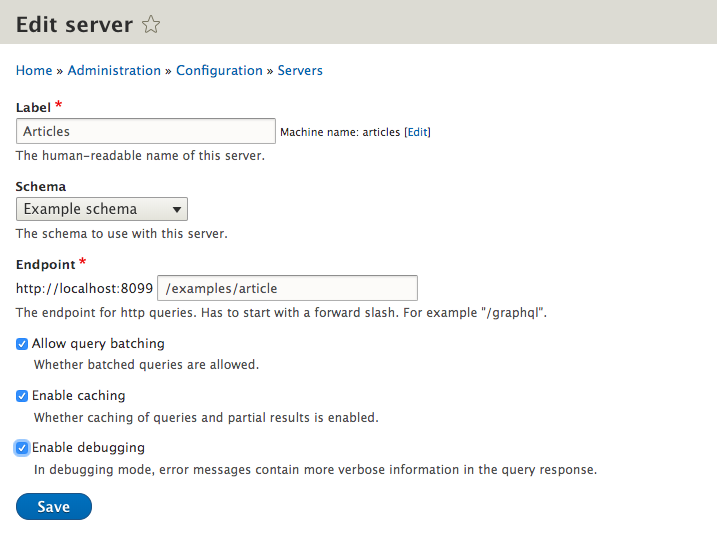
The last thing you need to do is tell graphql-php to execute the incoming query. 'resolve' => function($root_value, $args) Step Five: Execute and Serve the Graphql Response 'type' => Type::listOf($list_recipient_type), $list_recipients_query = new ObjectType([ 'description' => 'The recipient list node ID', 'description' => 'The recipient contact node ID',
#Drupal graphql install
We’ll start with a basic Drupal controller. Installing GraphQL for Drupal Install the module with Composer, since it depends on a vendor library GraphQL-php If youre using a Composer based. Step One: Set up a Drupal route to serve Graphql
#Drupal graphql how to
In this article, I will be discussing how to implement a custom graphql-php endpoint and schema for interacting with a custom, non-entity data source.

However, there is one case that the Graphql module does not cover: building a Graphql schema for data that is not represented as a Drupal entity.

A React JS app that shows a catalog of products.Most of the time, the Drupal GraphQL module is the tool that you want. It'll be clear with an example.Have you ever wanted to interact with Drupal data through a GraphQL client? Lots of people do. We are not limited to show only one type of paragraph per field, to query all the values for the field_section we just need to list the supported fragments for that field. For example, the content type Page can have a field_sections field that references paragraphs of type tag_section for showing the latest tags, and a paragraph of type articles_section for the latest articles. ,Ī very common use case for paragraphs is when a content type has a field that can reference multiple types of paragraphs. So, to get the 10 latest articles of Sports section, we can use the next query. For the sake of simplicity, suppose that sections are stored as strings. Imagine that our content type Article has the field field_section that indicates the section the article belongs to. On the other hand, the nodes' fragments name has the form Node + Content Type name, so the fragment for the content type Article is NodeArticle. Remember that fields and properties are in camelCase, so field_kicker becomes fieldKicker. For example, suppose that we have the Article content type, and it has the field_kicker field, so in order to get the value of the field_kicker, wrap the fieldKicker field inside the NodeArticle fragment. If we want to retrieve fields that belong only to a specific content type we have to use the fragment associated with that content type.

GraphQL Metatag issues credited to Dotsquares Ltd. Get a single node of a specific content type by its nid Drupal 10, the latest version of the open-source digital experience platform with even more features, is here. Keep in mind that entityId belongs to all entities (a node is an entity), and title and status are fields of all nodes, regardless of their bundle. Only fields that belong to all entities and nodes can be fetched using this query. The explains the GraphQL as a query language for APIs and a runtime for fulfilling those queries with your existing data. To query the basic information about that node, we can use the query below. This list is not intended to be exhaustive, it's just a sample of common queries that I've used in almost all decoupled sites that I've worked on.

Here's a cheat sheet to show you a couple of examples of GraphQL queries using version 8.x-3.x of Drupal's GraphQL module.


 0 kommentar(er)
0 kommentar(er)
